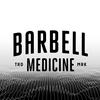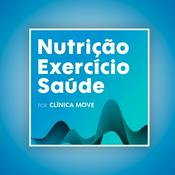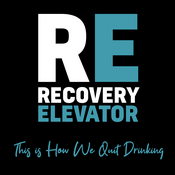410 episódios

Ozempic & Alcohol, The Trap Bar Myth, and A Medical Mystery | Barbell Medicine AMA Teaser
23/12/2025 | 30min
Experiencing a pins-and-needles sensation on a run or fearing the straight bar deadlift shouldn't be your fitness journey's bingo card. Many trainees abandon effective habits due to false narratives regarding physiological signals or myths regarding back safety. We break down the clinical reality of exercise-induced sensations, the ethics of modern metabolic medicine, and why your choice of imlpement is more about preference than peril.Resources and Next StepsFor evidence-based resistance training programs: barbellmedicine.com/training-programsFor individualized medical and training consultation: barbellmedicine.com/coachingExplore our full library of articles on health and performance: barbellmedicine.com/resourcesTo join Barbell Medicine Plus and get ad-free listening, product discounts, exclusive content, and more: https://barbellmedicine.supercast.com/TopicsThe Hemodynamic Itch: Why vasodilation and increased blood flow to capillaries can cause mechanical stimulation of nerve endings during a run.Exercise-Induced Anaphylaxis: The critical difference between benign "runner’s itch" and a systemic medical emergency involving hives and hemodynamic instability.Medical Paternalism: Why withholding GLP-1 medications from patients who drink alcohol is a flawed clinical approach that ignores aggregate health risk reduction.The Seatbelt Analogy: Treating one health risk (obesity) is objectively better than leaving it untreated, even if other risks (alcohol) remain constant.The EMG Trap: Why electrical muscle activity data is a poor predictor of long-term strength and hypertrophy outcomes compared to longitudinal studies.Biomechanical Distribution: How the trap bar shifts load toward the quadriceps while the straight bar emphasizes the hamstrings and erectors without changing "safety."Clinical PearlsIdentify Red Flags: If itching is accompanied by wheezing, nausea, or dizziness, stop exercise immediately and seek emergency medical care.Prioritize Habituation: For benign runner’s itch, consistent training typically leads to physiological adaptation and symptom resolution within a few weeks.Shared Decision-Making: When choosing between deadlift variations, select the tool that aligns with your specific goals—use the straight bar for powerlifting prep and the trap bar for general strength or power development.Timestamps00:00 – Intro to the Direct Line AMA series00:43 – The Mystery of "Runner’s Itch": Mechanisms and Hemodynamics04:19 – Case Study: 24-year-old Marine and Exercise-Induced Anaphylaxis06:22 – Summary: Benign Itching vs. Cholinergic Urticaria vs. Anaphylaxis07:24 – GLP-1 Receptor Agonists and Heavy Alcohol Use10:57 – Beyond the Stomach: How GLP-1s Impact Brain Reward Pathways15:32 – Avoiding Paternalism in Medicine: Shared Decision-Making18:12 – The Great Deadlift Debate: Trap Bar vs. Straight Bar21:31 – Why EMG Data is Often Misleading for Trainees24:54 – Debunking the "Save Your Back" MythOur Sponsors:* Check out FIGS and use my code FIGSRX for a great deal: https://wearfigs.com* Check out Factor: https://factormeals.com/bbm50off* Check out Quince: https://quince.com/BBM* Check out Rosetta Stone and use my code TODAY for a great deal: https://www.rosettastone.com* Check out Washington Red Raspberries: https://redrazz.orgSupport this podcast at — https://redcircle.com/barbell-medicine-podcast/donationsAdvertising Inquiries: https://redcircle.com/brandsPrivacy & Opt-Out: https://redcircle.com/privacy

START HERE: The Cholesterol Action Plan Series
20/12/2025 | 2min
Welcome to the Barbell Medicine Cholesterol Action Plan. Cardiovascular disease is the #1 killer globally. We just released a massive 6-part audio series and written guide to fix that.It covers ApoB vs LDL, the CAC score paradox, the P:S diet ratio, and Plaque Regression.The full series is available INSTANTLY for Barbell Medicine Plus subscribers.If you're not a subscriber, start here:https://barbellmedicine.supercast.com/ Our Sponsors:* Check out FIGS and use my code FIGSRX for a great deal: https://wearfigs.com* Check out Factor: https://factormeals.com/bbm50off* Check out Quince: https://quince.com/BBM* Check out Rosetta Stone and use my code TODAY for a great deal: https://www.rosettastone.com* Check out Washington Red Raspberries: https://redrazz.orgSupport this podcast at — https://redcircle.com/barbell-medicine-podcast/donationsAdvertising Inquiries: https://redcircle.com/brandsPrivacy & Opt-Out: https://redcircle.com/privacy

Episode 379: Menopause Myths, Cortisol Belly, & The Truth About IUDs
16/12/2025 | 1h 6min
The wellness industry wants you to believe that menopause renders you fragile, fasting creates "cortisol belly," and birth control is silently destroying your skeletal health. These claims aren't just scientifically inaccurate; they act as "nocebo" barriers that scare women away from effective training and healthcare.We brought in the heavy artillery—Dr. Lauren Colenso-Semple, Dr. Loraine Baraki, and Dr. Spencer Nadolsky—to dissect the physiology behind these viral fears. Discover why your body remains resilient through hormonal transitions and why lifestyle or GLP-1s is a false dichotomy, Dr. Colenso-Semple: @drlaurencs1Dr. Loraine Baraki: @loraine_barbellmedicineDr. Spencer Nadolsky: @drnadolskyKey Learning PointsThe Menopause "Cliff" Myth: Menopause does not destroy your ability to recover or adapt to exercise.1 While aging may require programming adjustments, your muscles do not stop responding to tension and progressive overload simply because estrogen levels change.Cortisol Fear-mongering: There is no evidence that intermittent fasting or skipping breakfast causes pathological "cortisol belly" or visceral fat storage in women. Fasting is simply a tool for Calorie restriction, not a hormonal wrecking ball.IUDs & Bone Density: Levonorgestrel IUDs (hormonal) work primarily via local action on the uterus, not systemic suppression. Contrary to viral claims, they do not "eat your bones," and most users continue to ovulate and produce protective estrogen.The "Masking" Fallacy: Amenorrhea (lack of period) on an IUD is a known, harmless side effect of a thinned uterine lining. It is rarely "masking" a dangerous underlying condition like premature ovarian insufficiency.Birth Control & Performance: Population-level data shows that hormonal contraceptives do not clinically impair strength or athletic performance. While they increase SHBG and lower free testosterone, women are not "little men" dependent solely on testosterone for performance.GLP-1 Agonists (Ozempic/Mounjaro): Using medication to treat the appetite dysregulation of obesity is not "cheating." Muscle loss on these drugs is primarily a function of the Caloric deficit, not the drug itself, and can be mitigated with resistance training.Get More Value: Exclusive Content and ResourcesWant to support the show and get early, ad-free access to all episodes plus exclusive bonus content? Subscribe to Barbell Medicine Plus and get ad-free listening, product discounts, and more. Try it free for 30-days.Unsure which training plan is right for you? Take the free Barbell Medicine Template Quiz to be matched with the ideal program for your goals and experience level.For media, support, or general questions, please contact us at [email protected] Pearls & TakeawaysProgramming for Menopause: Stop treating menopause as a disability. Continue to lift heavy (RPE 6-9) and perform conditioning. If recovery lags, adjust volume (sets/reps) before blaming hormones.Protein Simplified: Ignore the complex "ideal body weight" math. Aim for ~1.6g/kg of total body weight, or simply add one extra serving of protein (like a shake) to your current daily intake.Medical Decisions: Do not remove an IUD or avoid birth control solely due to social media fear-mongering about bone density or "low T." These choices should be based on your contraceptive needs and symptom management (e.g., PCOS, endometriosis).Timestamps00:00 Intro: The "Fragile Female" Narrative01:00 Does Menopause Destroy Recovery?11:00 Muscle Fiber Types: Fact vs. Fiction24:00 Fasting, "Cortisol Belly," and Visceral Fat34:00 Protein Intake: Survival vs. Optimal41:40 Dr. Lorraine Baraki: Do IUDs Cause Bone Loss?50:00 Birth Control, Acne, and Athletic Performance59:00 Dr. Spencer Nadolsky: The Truth About GLP-1s & Muscle Loss01:05:00 Final Verdict: You Are Not FragileReferencesThomas, Ewan et al. “The effect of resistance training programs on lean body mass in postmenopausal and elderly women: a meta-analysis of observational studies.” Aging clinical and experimental research vol. 33,11 (2021): 2941-2952. doi:10.1007/s40520-021-01853-8 TWORoberts, Brandon M et al. “Sex Differences in Resistance Training: A Systematic Review and Meta-Analysis.” Journal of strength and conditioning research vol. 34,5 (2020): 1448-1460. doi:10.1519/JSC.0000000000003521Khalafi, Mousa et al. “The effects of exercise training on body composition in postmenopausal women: a systematic review and meta-analysis.” Frontiers in endocrinology vol. 14 1183765. 14 Jun. 2023, doi:10.3389/fendo.2023.1183765Staron, R S et al. “Fiber type composition of the vastus lateralis muscle of young men and women.” The journal of histochemistry and cytochemistry : official journal of the Histochemistry Society vol. 48,5 (2000): 623-9. doi:10.1177/002215540004800506 Hunter, Sandra K. “The Relevance of Sex Differences in Performance Fatigability.” Medicine and science in sports and exercise vol. 48,11 (2016): 2247-2256. doi:10.1249/MSS.0000000000000928Nuzzo, James L. “Narrative Review of Sex Differences in Muscle Strength, Endurance, Activation, Size, Fiber Type, and Strength Training Participation Rates, Preferences, Motivations, Injuries, and Neuromuscular Adaptations.” Journal of strength and conditioning research vol. 37,2 (2023): 494-536. doi:10.1519/JSC.0000000000004329Verdell, J. Tyler MD; Acker, Matthew MD. Does the LNG-IUD decrease BMD in adolescent females?. Evidence-Based Practice 23(4):p 10-11, April 2020. | DOI: 10.1097/EBP.0000000000000601Jäger, Ralf et al. “International Society of Sports Nutrition Position Stand: protein and exercise.” Journal of the International Society of Sports Nutrition vol. 14 20. 20 Jun. 2017, doi:10.1186/s12970-017-0177-8Tan, Yimei et al. “Effect of GLP-1 receptor agonists on bone mineral density, bone metabolism markers, and fracture risk in type 2 diabetes: a systematic review and meta-analysis.” Acta diabetologica vol. 62,5 (2025): 589-606. doi:10.1007/s00592-025-02468-5Our Sponsors:* Check out FIGS and use my code FIGSRX for a great deal: https://wearfigs.com* Check out Factor: https://factormeals.com/bbm50off* Check out Quince: https://quince.com/BBM* Check out Rosetta Stone and use my code TODAY for a great deal: https://www.rosettastone.com* Check out Washington Red Raspberries: https://redrazz.orgSupport this podcast at — https://redcircle.com/barbell-medicine-podcast/donationsAdvertising Inquiries: https://redcircle.com/brandsPrivacy & Opt-Out: https://redcircle.com/privacy

Episode #378: Bulletproof or Broken- Why 'Perfect Form' Is a Lie
08/12/2025 | 1h 23min
Bulletproof or Broken- Why 'Perfect Form' Is a Lie Episode SummaryIn this comprehensive episode, we dismantle the pervasive myth that the human body is a fragile machine susceptible to catastrophic injury from minor technique flaws. This narrative, often perpetuated by social media influencers screaming "Snap City," creates widespread fear avoidance behavior (kinesiophobia) that does more harm than good.By reviewing extensive epidemiological data, we demonstrate that obsessing over "perfect" technique has virtually zero correlation with injury risk. Instead, we explore the true drivers of pain and injury: improper load management (doing too much, too fast) and hyper-specialization (lack of movement variability).We also introduce the REP Model (Repeatable, Efficient, Points of Performance) as a practical compass for movement and provide a new framework for staying healthy: focus on robustness and managing your training dose, not fear-based mechanics.Timestamps00:00:00 - The Fragility Myth: The Body-as-a-Car Metaphor and the Nocebo Effect.00:11:31 - Defining Injury: Why the scientific data is a methodological mess.00:21:46 - Injury Rates Compared: The Gym vs. Running vs. Contact Sports.00:33:32 - MRI is a Liar: Understanding asymptomatic abnormalities ("wrinkles on the inside").00:39:10 - The Body-as-a-Bank-Account: A better analogy for capacity and load.00:41:59 - Suspect 1: Heavy Weight. (Verdict: Innocent).00:45:44 - Suspect 2: Orthopedic Cost & Exercise Selection. (Verdict: Innocent).00:49:53 - Suspect 3: Hyper-Specialization. (Verdict: Guilty).00:54:23 - Suspect 4: Movement Speed. (Verdict: Innocent).00:57:21 - Suspect 5: Age. (Verdict: Innocent - The "Old Man Strength" phenomenon).01:02:17 - Suspect 6: Anabolic Steroids. (Verdict: Guilty-ish).01:04:38 - Suspect 7: Accidents & Gravity Events. (Verdict: Guilty).01:08:22 - The Myth of the "Robotic" Elite Lifter: Why variability is a feature, not a bug.01:15:48 - The REP Model: A new framework for technique (Repeatable, Efficient, Points of Performance).01:20:01 - Conclusion: Your marching orders.⭐ Get More Value: Exclusive Content and ResourcesWant to support the show and get early, ad-free access to all episodes plus exclusive bonus content? Subscribe to Barbell Medicine Plus and get ad-free listening, product discounts, and more. Try it free for 30-days.Unsure which training plan is right for you? Take the free Barbell Medicine Template Quiz to be matched with the ideal program for your goals and experience level.For media, support, or general questions, please contact us at [email protected] plan : https://www.barbellmedicine.com/injury-risk-action-plan/I. The Fragility Myth: Why You Are Not a CarThe fitness industry has long relied on the "body-as-a-machine" metaphor to explain pain. The logic suggests that if your alignment is off—much like a car with bad wheel alignment—your parts will wear out and fail. This has led to a culture of fear where athletes spend 30 minutes warming up rotator cuffs or obsessing over a single degree of spinal flexion during a deadlift.However, this mechanical model is fundamentally flawed. Unlike a car, human tissues are adaptable.The Brake Pad vs. The Callus: If you drive a car daily, the brake pads get thinner until they break. If you expose your skin to a barbell daily, it doesn't wear away; it builds a callus.Wolf’s Law & Davis’ Law: Bones get denser, and tendons/ligaments thicken when exposed to appropriate stress.The Nocebo EffectThe greatest risk in the gym isn’t a rounded back; it’s the nocebo effect. This is the phenomenon where negative expectations or beliefs lead to negative outcomes. When influencers draw red lines on videos and catastrophize movement, they are socially transmitting pain and fear. This "socially transmitted kinesiophobia" convinces you that you are fragile, leading to hyper-vigilance and, ironically, a higher sensation of pain.Key Takeaway: You do not need to be fixed. You are robust and adaptable. The industry profits from your fragility, but the science supports your resilience.II. The Data Hierarchy of RiskTo understand the true risk of the gym, we must look at the epidemiology of injury. Unfortunately, the scientific community struggles to agree on a definition of "injury." Some studies count a stubbed toe, while others only count surgery.Despite this methodological mess, the trends in the data are clear: The gym is one of the safest places to be.Injury Rates by Activity (Per 1,000 Hours)Bodybuilding: 0.2 – 1.0Powerlifting / Weightlifting: 1.0 – 4.0Running: ~10 (Novices up to ~18)Field Sports (Soccer, Rugby): 15 – 80+Motocross: >90The perception that lifting heavy weights is dangerous while recreational sports are "safe fun" is backward. The gym is a controlled environment where you dictate the load, tempo, and rest. In contrast, field sports are chaotic, "dirty" environments with high impact forces and unpredictable variables.MRI is a Liar: The "Wrinkles on the Inside"Modern medicine often over-relies on imaging. Studies on asymptomatic populations (people with no pain) show:High rates of disc bulges and degeneration in healthy adults."Abnormalities" in 100% of elite baseball pitchers' shoulders.These findings are often adaptations, not pathologies. Just as you get wrinkles on your skin as you age, you get "wrinkles" on your spine. Treating an MRI finding rather than the person leads to unnecessary fear and medical interventions.III. The True Culprit: Load ManagementIf technique isn't the primary driver of injury, what is? The answer lies in the balance between Load and Capacity.Think of your body as a Bank Account:Capacity: The funds you have in the bank ($1,000).Load: The withdrawal you are trying to make ($1,200).Injury/Pain: The overdraft fee.Pain occurs when the training load exceeds your current tissue capacity. The form police believe the overdraft happened because you swiped the debit card with your left hand (technique). In reality, the overdraft happened because you spent too much money.The Lineup of Suspects: Who is Guilty?We analyzed the common scapegoats for gym injuries to determine their actual guilt based on the evidence.Suspect: Heavy WeightVerdict: Innocent. Powerlifters (high load) have similar or lower injury rates than runners (low load).Suspect: Orthopedic Cost / Exercise SelectionVerdict: Innocent. Squats and deadlifts are not "expensive" to joints; they are investments that build bone density and tissue strength.Suspect: Hyper-SpecializationVerdict: Guilty. Doing the exact same movement pattern (same stance, same tempo, same shoe) for years creates overuse issues. Variation "rotates the tires" and spreads stress across tissues.Suspect: Movement SpeedVerdict: Innocent. Olympic weightlifting (high velocity) is as safe as powerlifting. It comes down to preparation, not speed.Suspect: AgeVerdict: Innocent (Inverse Trend). Older lifters tend to have lower injury rates than younger lifters, likely due to "old man strength" (accumulated capacity), better autoregulation, and less ego-lifting.Suspect: Anabolic SteroidsVerdict: Guilty-ish. Steroids allow muscles to adapt faster than tendons and ligaments, creating a "Ferrari engine in a Honda Civic" mismatch.Suspect: Accidents (Gravity Events)Verdict: Guilty. A significant portion of gym injuries are simply dropping weights on toes or tripping.IV. Technique: The Compass, Not the RulebookWe have been taught that elite lifters move like robots—that every rep is identical. However, motion capture data reveals that elite athletes exhibit significant movement variability (motor noise) from rep to rep. This variability is a feature, not a bug; it allows the biological system to solve the problem of "lifting the weight" in real-time.Instead of forcing your body into a rigid, robotic ideal, we utilize the REP Model as a compass for technique.The REP ModelR - Repeatable: Can you perform the movement with relatively consistent range of motion and patterns? (Your squat should look like a squat, not a Good Morning).E - Efficient: Does the movement solve the problem with the least wasted energy? (e.g., keeping the bar close in a deadlift).P - Points of Performance: Does it meet the specific constraints of your goal? (e.g., squatting below parallel for powerlifting standards).If your lift meets these criteria, your technique is likely safe and effective. You do not need a "neutral spine" to be safe—in fact, keeping a truly neutral spine during a heavy deadlift is anatomically impossible.V. Actionable TakeawaysIt is time to stop playing defense with your training and start playing offense.Stop optimizing for "safety" by avoiding exercises. You are safer in the squat rack than almost anywhere else. Use a wide variety of exercises to build a broad base of capacity.Abandon the Robotic Mindset. Use the REP Model. If the lift is repeatable, efficient, and meets your goals, stop obsessing over millimeter deviations.Manage the Dose. This is the single most important variable for health. Most injuries are "too much, too soon." Keep the majority of your training in the RPE 6–8 range. Build the callus; don't rub until you get a blister.References Aagaard, P., et al. (1996). Neural adaptation to resistance training: changes in evoked V-wave and H-reflex responses. Journal of Applied Physiology.Aasa, U., et al. (2017). Injuries among weightlifters and powerlifters: a systematic review. British Journal of Sports Medicine.Aasa, U. (2019). (Likely referring to a follow-up study or commentary on powerlifting injuries, e.g., Preventing injuries in weightlifting and powerlifting).Bahr, R. (2009). No injuries, but plenty of pain? On the methodology for recording overuse symptoms in sports. British Journal of Sports Medicine.Bahr, R., et al. (2011). International Olympic Committee consensus statement: Methods for recording and reporting of epidemiological data on injury and illness in sport. British Journal of Sports Medicine. (PMID: 21719329)Bartlett, R. M., et al. (2007). Fast bowling laws of cricket and their impact on the lumbar spine. Journal of Sports Sciences. (PMID: 17449180)Behm, D. G., & Sale, D. G. (1993). Velocity specificity of resistance training. Sports Medicine.Berger-Roscher, N., et al. (2017). Complex loading of the lumbar spine changes the failure mode of the intervertebral disc. Clinical Biomechanics.Bible, J. E., et al. (2010). Normal functional range of motion of the lumbar spine during 15 activities of daily living. Journal of Spinal Disorders & Techniques.Callaghan, J. P., & McGill, S. M. (2001). Intervertebral disc herniation: studies on a porcine model exposed to highly repetitive flexion/extension motion with compressive force. Clinical Biomechanics.Campbell, B., et al. (2014). International Society of Sports Nutrition position stand: energy drinks. Journal of the International Society of Sports Nutrition. (Note: "Campbell 2014" often refers to this, though a specific biomechanics paper is possible given the context).Claudino, J. G., et al. (2018). CrossFit Overview: Systematic review and meta-analysis. Sports Medicine - Open.Clausen, M. B., et al. (2014). High injury incidence in adolescent female soccer. American Journal of Sports Medicine.Colado, J. C., et al. (2009). Technique and safety aspects of resistance exercises: a systematic review of the literature. Physician and Sportsmedicine.Dhawale, A. A., et al. (2017). The prevalence of scoliosis in children with spinal cord injury. Journal of Pediatric Orthopaedics.Dominski, F. H., et al. (2018). Profile of injuries in CrossFit training. Physical Therapy in Sport.Faigenbaum, A. D., et al. (2010). Youth resistance training: updated position statement paper from the National Strength and Conditioning Association. Journal of Strength and Conditioning Research.George, P. E., et al. (1989). Acute back injuries in weight lifters. The Physician and Sportsmedicine.Gooyers, C. E., et al. (2015). The flexion–relaxation phenomenon: A review of the literature and update on the underlying biomechanics. Journal of Biomechanics. (PMID: 26162399 / PMC4505796)Hak, P. T., et al. (2013). The nature and prevalence of injury during CrossFit training. Journal of Strength and Conditioning Research. (PMID: 24022651)Hay, D. C., et al. (2015). Spinal injuries in golf. Asian Journal of Sports Medicine. (PMID: 25646361)Hill, A. V. (1922). The maximum work and mechanical efficiency of human muscles, and their most economical speed. The Journal of Physiology.Jacobsson, J., et al. (2013). Injury patterns in Swedish elite athletics: annual incidence, injury types and risk factors. British Journal of Sports Medicine.Keogh, J. W., & Winwood, P. W. (2017). The Epidemiology of Injuries Across the Weight-Training Sports. Sports Medicine. (PMID: 28597618)Kim, M. H., et al. (2014). Effects of different trunk exercises on trunk muscle activation. Journal of Physical Therapy Science.Klimek, C., et al. (2018). Are injuries more common in CrossFit training than other forms of exercise? Journal of Sports Rehabilitation.Kristiansen, E., et al. (2019). A comparison of muscle activation during the bench press and dumbbell fly. Journal of Sports Sciences.Kwon, Y. J., et al. (2011). The effect of core stability training on performance. Journal of Strength and Conditioning Research.Latash, M. L. (2012). The bliss of motor abundance. Experimental Brain Research. (PMC3445213)Martimo, K. P., et al. (2008). Effect of training on the perception of back pain and disability: a meta-analysis of randomized controlled trials. Spine. (PMID: 18244957)McGill, S. M. (2012). Low Back Disorders: Evidence-Based Prevention and Rehabilitation. Human Kinetics. (See also PMID: 22773066)Montalvo, A. M., et al. (2017). Retrospective injury epidemiology and risk factors for injury in CrossFit. Journal of Sports Science & Medicine.Morin, J. B., et al. (2016). Technical ability of force application as a determinant factor of sprint performance. Medicine & Science in Sports & Exercise.Mueller-Wohlfahrt, H. W., et al. (2013). Terminology and classification of muscle injuries in sport: the Munich consensus statement. British Journal of Sports Medicine. (PMC3607100)Mundt, D. J., et al. (1993). An epidemiologic study of low back pain. Spine.Myer, G. D., et al. (2009). The effects of plyometric vs. dynamic stabilization and balance training on lower extremity biomechanics. American Journal of Sports Medicine.Nordin, M., & Frankel, V. H. (2019). Basic Biomechanics of the Musculoskeletal System. (Textbook).Panjabi, M. M. (1992a). The stabilizing system of the spine. Part I. Function, dysfunction, adaptation, and enhancement. Journal of Spinal Disorders.Panjabi, M. M. (1992b). The stabilizing system of the spine. Part II. Neutral zone and instability hypothesis. Journal of Spinal Disorders.Potvin, J. R., et al. (1991). Trunk muscle and lumbar ligament contributions to dynamic lifts with varying degrees of trunk flexion. Spine.Raske, A., & Norlin, R. (2002). Injury incidence and prevalence among elite weight and power lifters. American Journal of Sports Medicine.Ribeiro, A. L., et al. (2012). Exercise selection and resistance training. Journal of Strength and Conditioning Research.Rodriguez, M. A., et al. (2020). Injury in CrossFit: A systematic review of epidemiology and risk factors. The Physician and Sportsmedicine. (PMC7318830)Schollum, M. L., et al. (2018). Sense of effort and force production in the spine. Journal of Biomechanics.Setchell, J., et al. (2017). Individuals' explanations for their persistent or recurrent low back pain: a cross-sectional survey. BMC Musculoskeletal Disorders.Shaw, G., et al. (2020). (Likely Shaw et al. regarding concussion or injury epidemiology).Siewe, J., et al. (2014). Injuries and overuse syndromes in competitive and elite bodybuilding. International Journal of Sports Medicine. (PMID: 24886919 / PMC3960980)Sjöberg, H. (2018). (Associated with the Aasa/Strömbäck powerlifting injury studies, likely a thesis or co-authored paper).Strömbäck, E., et al. (2018). Prevalence and Consequences of Injuries in Powerlifting: A Cross-sectional Study. Orthopaedic Journal of Sports Medicine.Veres, S. P., et al. (2010). Sub-failure pressurization of the intervertebral disc causes herniation. Spine.Vialle, R., et al. (2005). Radiographic analysis of the sagittal alignment and balance of the spine in asymptomatic subjects. Journal of Bone and Joint Surgery. (PMID: 15972618)Vigotsky, A. D., et al. (2015). Biomechanical effects of good morning, spinal flexion, and spinal extension exercises. Journal of Strength and Conditioning Research. (PMID: 25951917)Wade, S. M., et al. (2017). Injury risk of CrossFit participants. Orthopaedic Journal of Sports Medicine.Weisenthal, B. M., et al. (2014). Injury rate and patterns among CrossFit athletes. Orthopaedic Journal of Sports Medicine.Williams, S., et al. (2013). Kinesio taping in treatment and prevention of sports injuries: a meta-analysis. Sports Medicine.Winwood, P. W., et al. (2014). Retrospective injury epidemiology of strongman athletes. Journal of Strength and Conditioning Research. (PMID: 25031367)Wu, X., et al. (2014). Effects of core strength training on core stability. Journal of Physical Therapy Science.Our Sponsors:* Check out FIGS and use my code FIGSRX for a great deal: https://wearfigs.com* Check out Factor: https://factormeals.com/bbm50off* Check out Quince: https://quince.com/BBM* Check out Rosetta Stone and use my code TODAY for a great deal: https://www.rosettastone.com* Check out Washington Red Raspberries: https://redrazz.orgSupport this podcast at — https://redcircle.com/barbell-medicine-podcast/donationsAdvertising Inquiries: https://redcircle.com/brandsPrivacy & Opt-Out: https://redcircle.com/privacy

Episode 377: GLP-1 Anti-Obesity Medications Update-Efficacy, Muscle Risk, and Future
02/12/2025 | 1h 26min
Episode Summary: The Cardiometabolic Revolution of Semaglutide, Tirzepatide, and BeyondThis episode provides a comprehensive, evidence-based update on GLP-1 receptor agonists (anti-obesity medications), featuring Dr. Jordan Feigenbaum, Dr. Austin Baraki, and Dr. Spencer Nadolsky. The hosts review the rapid evolution of these drugs—from short-acting injectables to potent multi-agonists like Tirzepatide (Mounjaro/Zepbound) and Retatrutide—which now achieve weight loss efficacy rivaling bariatric surgery.The discussion clarifies the broad, weight-independent benefits these drugs offer for cardiovascular, renal, and liver health (CKM Syndrome). The experts address common concerns, including the high incidence of gastrointestinal side effects and the heavily debated risk of muscle mass loss, concluding the risk is often overblown and easily mitigated by resistance training and adequate protein intake. Finally, they discuss the biggest hurdle to access: cost, and the role of newer oral and compounded options in the evolving landscape.⏱️ Episode Timestamps00:00 Welcome and Introductions00:05:48 Defining GLP-1 and the Incretin Effect00:08:06 Debunking "Nature's Ozempic" (DPP-4 resistance)00:11:17 Evolution of GLP-1 Drugs (Longer duration, higher potency)00:14:35 Defining and Discussing "Food Noise"00:19:43 Semaglutide Efficacy (STEP & SUSTAIN Trials)00:22:36 Tirzepatide Efficacy (SURMOUNT Trials)00:24:50 Triple Agonist Pipeline (Retatrutide)00:28:04 Oral Options and Future Accessibility (Orforglipron)00:33:10 Weight-Independent Cardio Benefits (SELECT Trial)00:38:12 Benefits for Kidney and Liver Health (CKM Syndrome)00:41:47 Emerging Benefits (Sleep Apnea, Addiction, Cancer)00:48:20 Common Side Effects (Nausea, Constipation, Fatigue)00:52:59 Rare/Serious Risks (Pancreatitis, NAION)00:58:36 Muscle Mass Loss Concern (Hype vs. Data)01:13:44 Biggest Hurdle: Cost and Prior Authorization01:16:50 Compounded Versions vs. Research Chemicals01:19:57 Role of Older Anti-Obesity Medications and Microdosing01:24:41 Final Summary🔗 Resources and Next StepsWork with Experts on Cardiometabolic Health:Connect with Dr. Austin Baraki and Dr. Spencer Nadolsky: https://joinvineyard.com/ For evidence-based resistance training programs: barbellmedicine.com/training-programsFor individualized medical and training consultation: barbellmedicine.com/coachingExplore our full library of articles on health and performance: barbellmedicine.com/resourcesTo join Barbell Medicine Plus and get ad-free listening, product discounts, exclusive content, and more: https://barbellmedicine.supercast.com/I. Basic Science and The Evolution of Anti-Obesity MedicationDefining GLP-1 and the Incretin EffectGLP-1 (Glucagon-like peptide 1) is a naturally occurring peptide hormone released by the intestines after food ingestion.1 It plays a role in the incretin effect, which enhances insulin secretion from the pancreas.2 However, natural GLP-1 is quickly broken down by the DPP-4 enzyme, limiting its efficacy.3 Modern GLP-1 receptor agonists (like Semaglutide and Tirzepatide) are synthetic analogs engineered to be resistant to DPP-4 breakdown, allowing them to stick around longer and reach receptors in the brain to modulate appetite.The concept of food noise describes the persistent, relentless, non-hunger-related thoughts about food that many individuals with obesity experience.5 Patients often report that the cessation of this food noise is one of the most profound effects of the medication, freeing up cognitive energy previously dedicated to ruminating over food.The Rapidly Advancing PipelineThe evolution of this drug class has been defined by three trends:Duration: Moving from twice-daily injections (Exenatide) to weekly injections (Ozempic) and future monthly options.Potency: Increasing efficacy through molecular engineering and multi-agonist targeting (e.g., Tirzepatide hitting GLP-1 and GIP receptors).7Tolerability: Improving the side effect profile, making newer agents easier to tolerate.Upcoming agents include oral options like Orforglipron and high-dose oral Semaglutide, which promise easier administration and potentially lower costs.8 Triple agonists like Retatrutide are showing efficacy in the mid-20% total weight loss range, rivaling metabolic surgery outcomes.II. Efficacy and Broad Health BenefitsWeight Loss EfficacyThe clinical data demonstrates significant efficacy, classifying these drugs as game-changers:Semaglutide (Ozempic/Wegovy): Averages around 15% total body weight loss.10Tirzepatide (Mounjaro/Zepbound): Averages 20-21% total body weight loss, generally showing superiority and improved tolerability compared to Semaglutide.11Pipeline Agents (Retatrutide): Showing potential for 24-25% total weight loss, pushing pharmacological intervention into the same league as bariatric surgery.Weight-Independent Organ Protection (CKM Syndrome)A significant portion of the benefit derived from these medications is weight-independent, meaning it's separate from the mass lost.12 The drugs exert pleiotropic (multiple) effects across organ systems, leading to the coining of CKM Syndrome (Cardiovascular-Kidney-Metabolic Syndrome).Cardiovascular Health: The SELECT trial demonstrated a radical reduction in Major Adverse Cardiovascular Events (MACE), with evidence suggesting at least two-thirds of this benefit is independent of the weight lost.Renal and Liver Health: Trials like FLOW are demonstrating benefits for Chronic Kidney Disease (CKD) progression.14 Furthermore, resolution or significant improvement of Fatty Liver Disease is commonly observed once weight loss exceeds the 7.5-10% threshold.Emerging and Future BenefitsResearch is exploring the impact of GLP-1 agonists on:Obstructive Sleep Apnea (OSA): Leading to resolution or reduction in severity, confirmed in trials.Addiction: Early anecdotal and some retrospective data show reduced alcohol consumption, with potential benefits being explored for gambling and opioid addiction due to strong effects in the brain's reward center.Neuroprotection and Cancer: The potential for favorable effects on neurodegenerative disease and certain adiposity-associated cancers is under investigation.III. Side Effects and Mitigating Muscle Loss ConcernsCommon and Rare Side EffectsThe vast majority of side effects are Gastrointestinal and highest during the initial dose escalation:Nausea: Most common, but typically resolves over time. Management includes smaller, more frequent meals and temporarily lower-fat diets.Constipation: Persistent and requires active management with fiber and potentially laxatives.Rare Risks: Pancreatitis is a common concern but has shown no increased incidence compared to placebo in trials. Gallstone development is linked to rapid weight loss by any mechanism, including bariatric surgery.Muscle Mass Loss: Hype vs. DataThe concern that these agents cause a unique, disproportionate amount of skeletal muscle loss is largely overblown hype.Initial Subgroup Analysis: Early analysis of Semaglutide trials suggested a higher proportion of fat-free mass loss (around 38%) than expected (25%). This was often cited as evidence of muscle catabolism.Physiological Reality: Experts suggest that much of the observed fat-free mass loss includes fluid shifts (glycogen, water) rather than pure skeletal muscle. Tirzepatide trials showed fat-free mass loss closer to the expected 25%.Muscle Quality Improves: Studies like SEMI-LEAN have shown that in patients with sarcopenia/obesity, muscle function (quality) actually improves despite some lean mass loss.Mitigation: The solution to minimizing any proportional muscle loss is simple: resistance training (2-3 days per week) and high protein intake (1.0 to 1.2 g/kg of body weight). Exercise is the primary controller here, minimizing the effect of the agents on the muscle compartment.IV. Access, Cost, and Future OutlookThe Biggest Hurdle: CostThe primary barrier to access remains cost, with list prices for branded medications often exceeding $1,000 per month, despite lower net costs for manufacturers.18 Insurance approval often requires complex Prior Authorization (PA) processes, which overwhelm standard primary care practices.The Role of Compounding and Older MedicationsCompounded Versions: Compounded versions are cheaper but lack safety and efficacy data from controlled trials. There are risks associated with the source and purity of the active pharmaceutical ingredient.19Older Medications: Older anti-obesity medications (e.g., Phentermine/Topiramate) still have a role, offering proven efficacy (though less potent) and significantly lower cost, serving as a bridge until GLP-1 prices decline.Future Trend: Prices are expected to drop significantly in the next 5-10 years, making the FDA-approved versions more accessible and rendering compounded versions largely obsolete.Our Sponsors:* Check out FIGS and use my code FIGSRX for a great deal: https://wearfigs.com* Check out Factor: https://factormeals.com/bbm50off* Check out Quince: https://quince.com/BBM* Check out Rosetta Stone and use my code TODAY for a great deal: https://www.rosettastone.com* Check out Washington Red Raspberries: https://redrazz.orgSupport this podcast at — https://redcircle.com/barbell-medicine-podcast/donationsAdvertising Inquiries: https://redcircle.com/brandsPrivacy & Opt-Out: https://redcircle.com/privacy
Mais podcasts de Saúde e fitness
Podcasts em tendência em Saúde e fitness
Sobre Barbell Medicine Podcast
Ouça Barbell Medicine Podcast, Huberman Lab e muitos outros podcasts de todo o mundo com o aplicativo o radio.net

Obtenha o aplicativo gratuito radio.net
- Guardar rádios e podcasts favoritos
- Transmissão via Wi-Fi ou Bluetooth
- Carplay & Android Audo compatìvel
- E ainda mais funções
Obtenha o aplicativo gratuito radio.net
- Guardar rádios e podcasts favoritos
- Transmissão via Wi-Fi ou Bluetooth
- Carplay & Android Audo compatìvel
- E ainda mais funções


Barbell Medicine Podcast
baixe o aplicativo,
ouça.






























